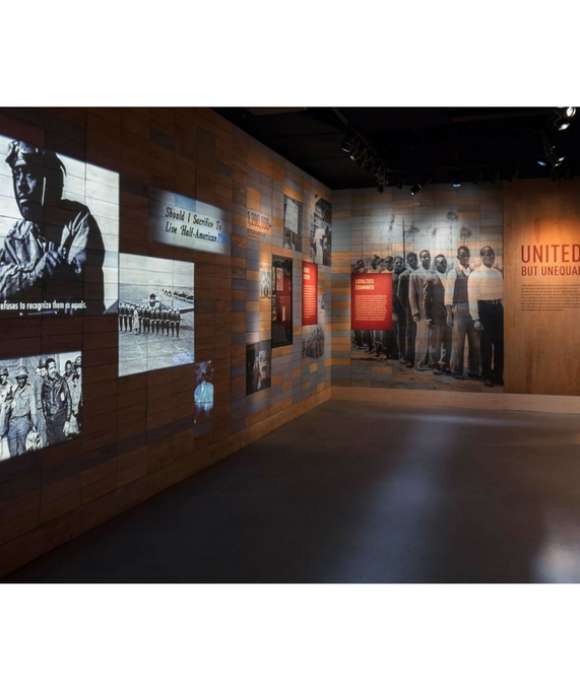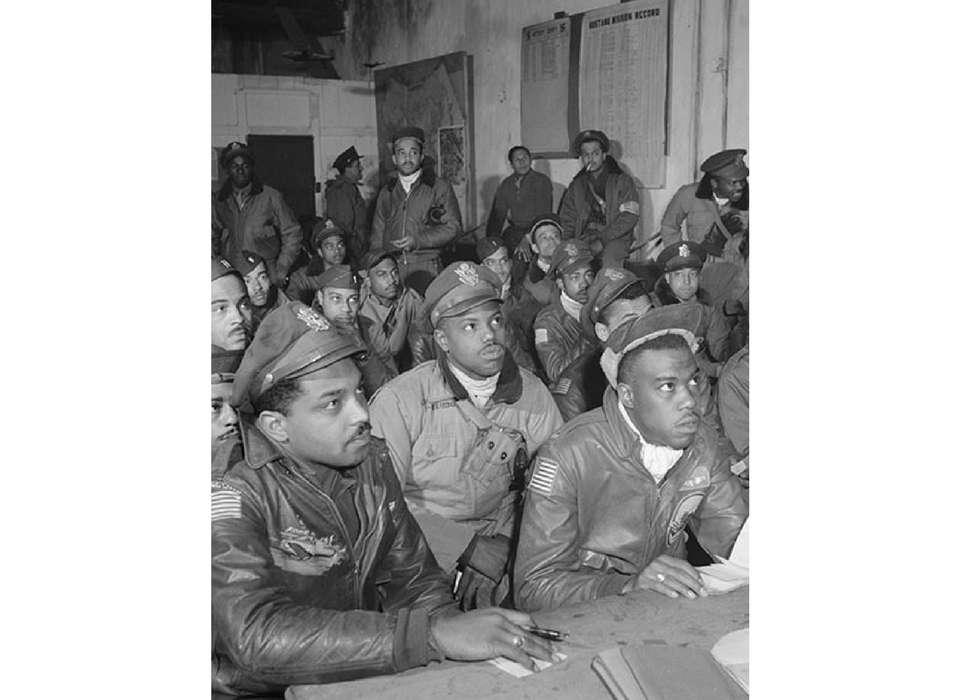"As the storm of war loomed on the horizon, African Americans faced prejudice and discrimination both in wartime industry and military service," wrote Keith Huxen, PhD, in the summer 2015 edition of V-Mail, the Museum's quarterly newsletter for Members. "In the expanding aircraft industry of 1940, less than 250 of over 100,000 workers were black, and some companies let it be known that they would not hire even qualified blacks. The US Marine Corps and the Army Air Corps barred blacks from their service. The US Army and US Navy took limited numbers of African Americans, but the Army segregated them into separate units while the Navy confined service opportunities to positions as cooks and stewards.
"The demands of war and the ambitions of African Americans to serve their country and prove their quality as citizens would change these circumstances with far-reaching historical reverberations."
In his V-Mail essay, Huxen, Senior Director of Research and History in the Museum's Institute for the Study of War and Democracy, was setting the stage for the July 2015 grand opening of the special exhibit Fighting for the Right to Fight: African American Experiences in World War II. The exhibit is currently traveling the country. Having already visited the St. Petersburg (Florida) Museum of History the Dallas Holocaust Museum Center for Education and Tolerance, and Omaha's The Durham Museum, the exhibit will be on view at the Oregon Historical Society from July 12, 2019, to December 31, 2019.
The website built for the "Fighting for the Right to Fight" special exhibit spotlights African American experiences before, during, and after the war, and includes downloadable resources (essays, biographies, lesson plans) for middle school and high school classrooms. The wartime section of the site contains breakout sections on the experiences of black servicemembers in every branch of the armed forces as well as men and women Home Front workers of color.
The site is an ideal starting point for a Black History Month exploration of wartime African American stories, and a good introduction to the many educational resources on the topic in the Museum's Digital Collections. Assets include oral histories, study guides, essays, and archived video of panels, presentations, and webinars.
Distance Learning
Of special interest to middle school and high school educators is the archived Electronic Field Trip from 2018 that extended the themes of the Fighting for the Right to Fight special exhibit into classrooms across the country. In this live 50-minute program, student reporters examined artifacts from the special exhibit, traveled to California to learn about injustices in a segregated military at Port Chicago Naval Magazine National Memorial (the site of the deadliest munitions disaster during the war), and explored Rosie the Riveter/WWII Home Front National Historical Park to understand transitions and tensions in American defense factories. During the webcast, students had the opportunity to participate live through polling and Q&A with Museum experts. Make note of this special presentation and share it with your students.
In addition, classrooms can connect directly with a Museum educator via the Double Victory: African Americans in WWII Virtual Field Trip. Your students will meet Pearl Harbor hero Dorie Miller, the Montford Point Marines, the Tuskegee Airmen, and the seven African American Medal of Honor recipients on this interactive, fast-paced learning experience.

United but Unequal: I Am an American gallery
While the cause of victory over the Axis powers united Americans, the racial supremacy championed by the Axis powers also refracted light on issues of national loyalty and race in America, exposing tensions that could not be ignored. This gallery in The Arsenal of Democracy exhibit revisits that history.
Digital Collections
Among the Museum's collection of nearly 10,000 personal stories from the war era are many oral histories of African Americans who served in wartime. The list includes Vernon Baker (one of seven African American Medal of Honor recipients for service during World War II), and Tuskegee Airmen John Leahr, William Holloman III, Charles McGee, and Roscoe Brown. Servicemembers from other branches of the armed forces include Joseph Hairston (Army), Wallace Baptiste (Navy), and Eugene Tarrant (Navy). A November 2017 essay for The War section of the Museum's website (with embedded oral history excerpt) profiled Harold Ward, a witness to the attack on Pearl Harbor and the Naval Battle of Guadalcanal. Watch Harold Ward's full oral history here.
The Museum's collection of wartime high school yearbooks includes Dunbar High School (an all-African American school in Dayton, Ohio) and segregated Topeka (Kansas) High School.
Lectures and Presentations
Lectures and presentations include a Lagniappe Lecture about Segregation during World War II, author Robert Child discussing his book The Lost Eleven (about the Nazi massacre of 11 African American soldiers during the Battle of the Bulge), and John Morrow, cochair of the special exhibit's advisory committee, presenting on African Americans in World War II. At a Meet the Author event, Daniel Haulman, PhD, presented his book The Tuskegee Airmen Chronology: A Detailed Timeline of the Red Tails and Other Black Pilots of World War II.
Also online and available for replay are presentations staged while the Fighting for the Right to Fight special exhibit was on display at the Museum. These include a panel presentation about the seven Medal of Honor recipients, and symposium panels about the postwar fight for civil rights and the changing role of African Americans in the 20th-century US military.
Finally, there is archived video of the April 2016 dedication ceremony for a newly restored P-51 Mustang, painted in the likeness of the plane flown in World War II by Red Tail Airman Roscoe Brown. The event was hosted by Robin and Sally-Ann Roberts, whose father, Colonel Lawrence Roberts, was a Tuskegee Airman. Watch the presentation below.
Cite this article:
MLA Citation:
APA Citation:
Chicago Style Citation:






![Max Fuchs, New York City cantor, sings as Rabbi Sydney [sic] Lefkowitz, Richmond, VA, conducts the first Jewish services from Germany.](/sites/default/files/styles/max_650x650/public/2025-10/image1.jpg)

